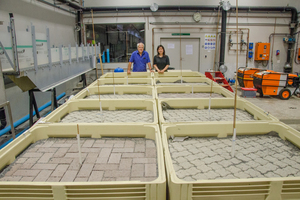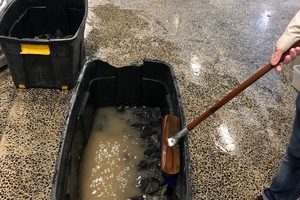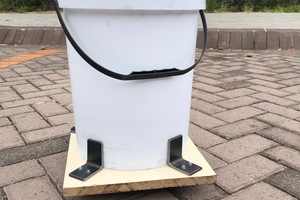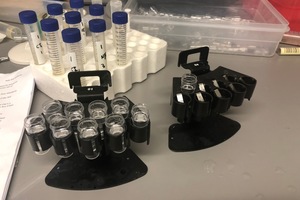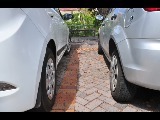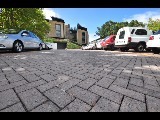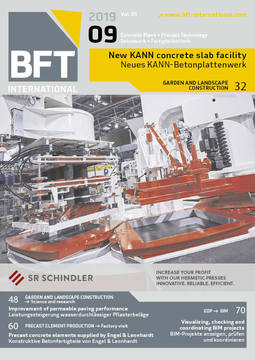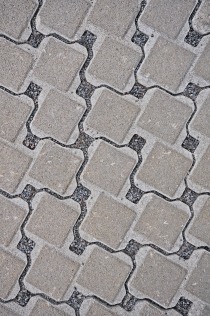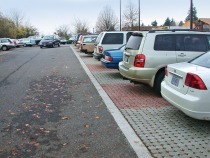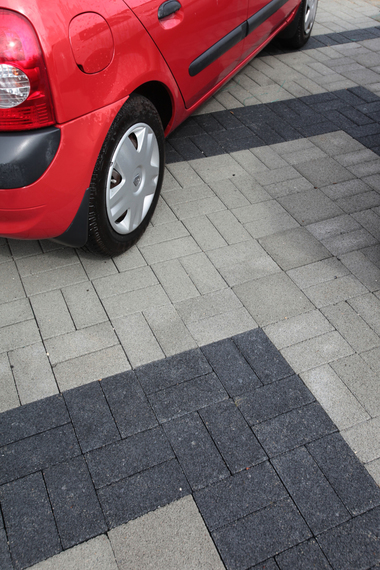UCT initiates research into improving South African permeable paving performance
The Civil Engineering Department of the University of Cape Town (UCT) has embarked on a research program, which aims at improving the performance of South African permeable paving installations. Deputy Director Neil Armitage is being assisted by a working group comprised of professionals and some civil engineering students.
The Civil Engineering Department of the University of Cape Town has embarked on a research program, which aims at improving the performance of South African permeable paving installations. Locally introduced 10 years ago, initial evidence suggests that permeable paving is not meeting its objectives of retarding the short-circuiting of storm water discharge nor the elimination of contaminants from storm water run-off with the desired level of success.
The research work is being spearheaded by Neil Armitage, Deputy Director: Future Water and a professor in UCT’s Department of Civil Engineering, and he is being assisted by a working group comprised of professionals and some civil engineering students. “Our research effort is twin pronged: gathering field data from permeable paving sites throughout the country, while simultaneously conducting laboratory experiments,” says Armitage. “Our field work focuses on the rate of storm water infiltration while our lab work deals with the removal of contaminants.
“As yet there is no national standard for the design, construction and maintenance of permeable paving. The current practice in SA is to simply copy overseas design guides in the hope that they work, without due regard to differing environmental conditions. Our prime objective is to devise a system or systems which work best under local conditions and to then provide evidence-based guidelines aimed at ensuring much improved systems which mimic, a closely as possible, the pre-development or nature-based hydrological cycle.
Blockage is the chief inhibitor of permeable paving performance
“Unlike attenuation ponds, swales or bio-cells, permeable paving does not require additional space. This is why it is being widely used in Cape Town’s urban environment where the City’s ‘Management of Urban Stormwater Impacts Policy (2009)‘ mandates the rate at which water can be released into storm water infrastructure and the quality or purity of the water. Blockage is the chief inhibitor of permeable paving performance and all the systems we have tested exhibit blocking, some more than others. Blocking has several causes, windblown sand (especially in Cape Town), vegetable matter, litter and cigarette butts to name a few. It is also caused by an internal build-up of sludge due to accumulated contaminants, especially in installations in which geofabric membrane has been laid as a filtering mechanism below the bedding course.
“Unwashed aggregate is another cause for concern and is one of the major reasons why permeable paving systems are not removing contaminants as they are designed to do. In fact, our recent laboratory experiments have shown that unwashed aggregate actually exacerbates water quality. Regular maintenance/cleaning is the only way of combating blocking. However, very little is being done in SA even though it is stipulated in all the guidelines. Cleaning is complicatedand as yet there is no fail-safe methodology. Various systems are employed such as sweeping, vacuuming, blowing with compressed air and spraying with water, all with limited degrees of success or no success at all.”
“For instance, we recently witnessed a cleaning operation at Steen Villa, a residential complex in Cape Town, where compressed air was used to remove sand-infested bedding grit and to replace it with clean grit. Once this operation had taken place, the paved surface remained blocked. The removal of some paving blocks then revealed that some of the dirt had been blown into rather than out of the installation and was wedged between the pavers and the geotextile membrane.”
Various methods of testing the infiltration rate
“What doesn’t help us is that some countries have got away with no maintenance for a long time. For example, an over 20 year-old installation in Hamburg, Germany, apparently has never been maintained and is still functioning, albeit only partially. However, the area in question is very large, and is situated in a soggy regular rainfall environment with no windblown sand. And because permeable paving has a design safety factor of 10 i.e. 10 times anticipated run-on, one can theoretically have 90% blockage before failure occurs. By contrast most South African installations tend to be much smaller and besides being subject to wind-blown sand, are often situated close to vegetation and trees. This means that a 90% blockage can occur in six months. In fact, if landscaping soil is dumped on a permeable paving surface a blockage can occur instantly.
There are various methods of testing the infiltration rate of permeable paving. We have found the international and American standards to be very onerous and very slow. It involves sealing the outside of a permeameter ring with a special putty and recording the time it takes for water to infiltrate. Instead we are using a simpler test, the SWIFT Method, devised in Queensland, Australia. It uses a wooden frame and a bucket, which releases six litres of water through a 14mm hole onto the paved surface. It is a very quick test and uses much less water than the American test.
One of the field test sites with which our team has been involved is right here on campus. It is a permeable paving parking area, which was constructed outside the New Engineering Building (NEB) six years ago. Using the SWIFT Method, a Masters student examined the water infiltration capacity of 60 locations situated within 13 sections. Her tests revealed five unblocked, two semi-blocked and six fully blocked sections. The worst blocking took place on the perimeter of the parking area, which was subject to the incursion of vegetable matter from the adjacent flower beds and trees, and, hardly surprisingly, the best or unblocked section was in the centre of the parking lot, i.e. furthest from the vegetation.”
Tests in a controlled environment
“Given that it’s very hard to measure the quality of water that passes through a permeable paving system, we had three sumps built for water sampling during construction of the NEB’s parking lot. The first simply receives contaminated roof run-off without any filtration. The second is fed with storm water after infiltrating through a geotextile membrane and three layers of aggregate. The layout for the last sump was the same as the second with the exception that we removed the geotextile. In theory, the water in sumps two and three should be relatively clean. That is the theory, but the practice turned out to be somewhat different. “During construction of the NEB’s parking area we replicated the test sections feeding through sumps two and three using exactly the same design and same materials in the laboratory so that we could run tests in a controlled environment. Then we built two further, completely different, designs.
‘Our testing on all four layouts involved simulating Cape Town’s average annual rainfall of 20 storms of 5mm and above. In addition, although we used clean tap water, what we got out was full of contaminants. Even after several cycles, we only achieved marginal improvement. Then we started doing projections and regression analysis to work out how long it would take before the water was squeaky clean. Our projections indicated that this could take well over 10 years. So, in the end we got tired of the process and told the student to flood and flush out test samples.
“He did that, and things started to improve. Then we stripped all four installations and we found a thick sludge layer at the bottom of each base course, which was clearly going to be there for ever. That is when we became aware of the fact that the aggregate was not clean even though the suppliers claimed it had been washed. We tried different cleaning methods using water hoses and after letting it dry for two days it still was not contaminant-free. It was only after we had brushed all the surfaces that the aggregate was clean. Thereafter when we poured in clean water, we got out clean water. We then reconstructed our test bins using properly cleaned aggregate.
“At that stage I visited Professor Bill Hunt of North Carolina State University in America who is conducting research into Low Impact Sustainable Drainage (LID) systems for North Carolina’s government and when I returned we began experimenting with some of things he was doing. For example, not using geotextiles, and instead using sumps at the bottom of permeable paving installations to create aerobic zones. The theory being that one can’t stop the ingress of dirt so rather let it settle at the bottom and take out the treated water from there. This is in contrast to the British Aquapave system, which treats the water just under the bedding course.
Quality of storm water and level of contaminants varies greatly
“The quality of storm water and level of contaminants varies greatly. But it would appear that nitrates and phosphates are the major culprits because they are widely used in garden fertilizers. One of our research students identified a commercially available fertilizer with a ratio of nitrates to phosphates, which allows us to dilute it to the typical concentrations one finds in storm water and it is now our proxy for mimicking polluted storm water.
“This means we can now repeat the typical CT rainy season using nutrient enriched tap water, measuring the difference in results with untreated tap water in 10 experimental cells in our laboratory using the same rainfall and contamination regimes. Three cells include a geotextile and some have missing stone layers. Each uses a different type of paving and stone support system. The bottom of each layout is perforated so we can remove sampling material.
“Unfortunately, we don’t have the luxury of changing one parameter at a time. So, in trying to hone down very quickly on which systems are working and which are not we have had to take a shotgun approach. One of the areas we are investigating is what happens during dry periods. For example, when the geotextile dries out and bacterial activity ceases. Then when it rains, again it has to re-seed much like a septic tank does. Therefore, it is possible that the use of a geotextile is better suited to soggy British weather as opposed to our conditions, which are hot and dry. Hence, the American idea of using a sump seems better suited to local conditions because a permanent pool of water provides a much better chance of creating a permanent bacteria culture to handle the incoming food load. Even if it is just ticking over, it is ready – at least that is our current thinking – and we are willing to try it as a more effective way of improving water quality.
We are also eager to try other ideas. I am particularly interested in people with some field experience; consultants, contractors, suppliers, etc. who are prepared to share information about their particular installations and designs. Even if it is just anecdotal. The more feedback we get back the more likely we are to find a pattern. We should then be able to begin building a permeable paving design guideline based on experiences across SA,” concludes Armitage.

